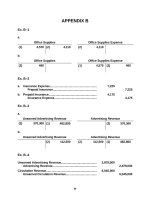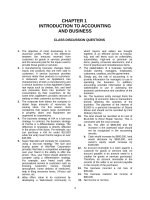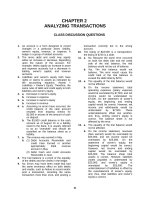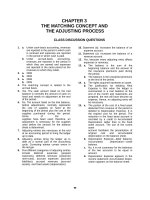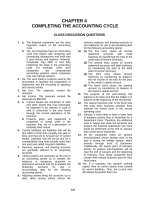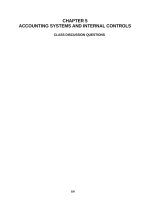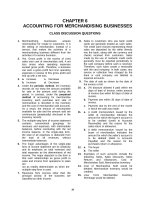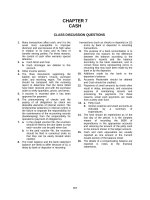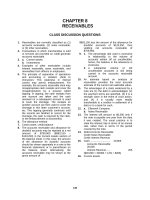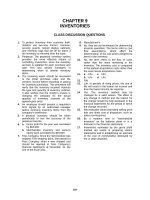Solution manual accounting 21e by warreni ch 01
Bạn đang xem bản rút gọn của tài liệu. Xem và tải ngay bản đầy đủ của tài liệu tại đây (320.19 KB, 41 trang )
CHAPTER 1
INTRODUCTION TO ACCOUNTING
AND BUSINESS
CLASS DISCUSSION QUESTIONS
1. The objective of most businesses is to
maximize profits. Profit is the difference
between the amounts received from
customers for goods or services provided
and the amounts paid for the inputs used to
provide those goods or services.
2. A manufacturing business changes basic
inputs into products that are then sold to
customers. A service business provides
services rather than products to customers.
A restaurant such as Applebee’s has
characteristics of both a manufacturing and
a service business in that Applebee’s takes
raw inputs such as cheese, fish, and beef
and processes them into products for
consumption by their customers. At the
same time, Applebee’s provides services of
waiting on their customers as they dine.
3. The corporate form allows the company to
obtain large amounts of resources by
issuing stock. For this reason, most
companies that require large investments
in property, plant, and equipment are
organized as corporations.
4. The business strategy of KIA is a low-cost
strategy. In contrast, the business strategy
of Porche is a differentiation strategy. The
difference in strategies is directly reflected
in the prices of the autos. For example, you
can purchase a KIA for under $10,000
while the entry level Porche begins at over
$40,000.
5. Super Wal-Mart will compete for customers
using a low-cost strategy. The size and
buying power of Wal-Mart Corporation
provides Wal-Mart a competitive advantage
over your friend in the ability to offer low
prices. Thus, your friend should attempt to
compete using a differentiation strategy.
For example, your friend could offer
personalized service to customers such as
knowing
customers’ names,
friendly
atmosphere, home delivery of medicines,
help in filing insurance forms, 24-hour call
service, etc.
6. eBay offers value to its customers by
developing a Web-based community in
7.
8.
9.
10.
11.
12.
13.
14.
15.
1
which buyers and sellers are brought
together in an efficient format to browse,
buy, and sell items such as collectibles,
automobiles, high-end or premium art
items, jewelry, consumer electronics, and a
host of practical and miscellaneous items.
The stakeholders of a business normally
include owners, managers, employees,
customers, creditors, and the government.
Simply put, the role of accounting is to
provide information for managers to use in
operating the business. In addition,
accounting provides information to other
stakeholders to use in assessing the
economic performance and condition of the
business.
No. The business entity concept limits the
recording of economic data to transactions
directly affecting the activities of the
business. The payment of the interest of
$3,600 is a personal transaction of Deana
Moran and should not be recorded by First
Delivery Service.
The land should be recorded at its cost of
$112,000 to Elrod Repair Service. This is
consistent with the cost concept.
a. No. The offer of $600,000 and the
increase in the assessed value should
not be recognized in the accounting
records.
b. Cash would increase by $600,000, land
would decrease by $500,000, and
owner’s equity would increase by
$100,000.
An account receivable is a claim against a
customer for goods or services sold. An
account payable is an amount owed to a
creditor for goods or services purchased.
Therefore, an account receivable in the
records of the seller is an account payable
in the records of the purchaser.
The business incurred a net loss of
$35,000.
The business realized net income of
$80,000.
Net income or net loss
Owner’s equity at the end of the period
Cash at the end of the period
2
EXERCISES
Ex. 1–1
1.
2.
3.
4.
5.
manufacturing
service
merchandise
service
service
6.
7.
8.
9.
10.
manufacturing
service
manufacturing
merchandise
manufacturing
11.
12.
13.
14.
15.
service
manufacturing
merchandise
service
manufacturing
6.
7.
8.
9.
10.
b—differentiation
b—differentiation
c—combination
a—low cost
b—differentiation
11.
12.
13.
14.
15.
a—low cost
b—differentiation
a—low cost
a—low cost
c—combination
Ex. 1–2
1.
2.
3.
4.
5.
a—low cost
a—low cost
b—differentiation
b—differentiation
c—combination
Ex. 1–3
As in many ethics issues, there is no one right answer. The local newspaper
reported on this issue in these terms: "The company covered up the first report,
and the local newspaper uncovered the company's secret. The company was
forced to not locate here (Collier County). It became patently clear that doing the
least that is legally allowed is not enough."
Ex. 1–4
1.
2.
3.
4.
B
B
E
F
5.
6.
7.
8.
B
F
X
E
Ex. 1–5
Coca-Cola owners’ equity: $24,501 – $12,701 = $11,800
PepsiCo owners’ equity: $23,474 – $14,183 = $9,291
9. X
10. B
Ex. 1–6
Toys “R” Us
Estée Lauder
$9,397 – $5,367 = $4,030
$3,417 – $1,955 = $1,462
Ex. 1–7
a. $96,500 ($25,000 + $71,500)
b. $67,750 ($82,750 – $15,000)
c. $19,500 ($37,000 – $17,500)
Ex. 1–8
a.
b.
c.
d.
e.
$275,000 ($475,000 – $200,000)
$310,000 ($275,000 + $75,000 – $40,000)
$233,000 ($275,000 – $15,000 – $27,000)
$465,000 ($275,000 + $125,000 + $65,000)
Net income: $45,000 ($425,000 – $105,000 – $275,000)
Ex. 1–9
a.
b.
c.
d.
e.
f.
owner's equity
liability
asset
asset
owner's equity
asset
Ex. 1–10
a.
b.
c.
d.
e.
Increases assets and increases owner’s equity.
Increases assets and increases owner’s equity.
Decreases assets and decreases owner’s equity.
Increases assets and increases liabilities.
Increases assets and decreases assets.
Ex. 1–11
a. (1)
(2)
(3)
Total assets increased $80,000.
No change in liabilities.
Owner’s equity increased $80,000.
b. (1)
(2)
(3)
Total assets decreased $30,000.
Total liabilities decreased $30,000.
No change in owner’s equity.
Ex. 1–12
1.
2.
3.
4.
increase
decrease
increase
decrease
Ex. 1–13
1.
2.
3.
4.
5.
6.
7.
8.
9.
10.
c
c
d
c
e
a
e
a
e
e
Ex. 1–14
a. (1)
(2)
(3)
(4)
(5)
(6)
(7)
Sale of catering services for cash, $25,000.
Purchase of land for cash, $10,000.
Payment of expenses, $16,000.
Purchase of supplies on account, $800.
Withdrawal of cash by owner, $2,000.
Payment of cash to creditors, $10,600.
Recognition of cost of supplies used, $1,400.
b. $13,600 ($18,000 – $4,400)
c. $5,600 ($64,100 – $58,500)
d. $7,600 ($25,000 – $16,000 – $1,400)
e.
$5,600 ($7,600 – $2,000)
Ex. 1–15
It would be incorrect to say that the business had incurred a net loss of $21,750. The
excess of the withdrawals over the net income for the period is a decrease in the
amount of owner’s equity in the business.
Ex. 1–16
Company M
Owner's equity at end of year
($1,200,000 – $650,000).............................................
Owner's equity at beginning of year
($750,000 – $300,000)................................................
Net income (increase in owner's equity)..............
$550,000
450,000
$100,000
Company N
Increase in owner's equity (as determined for M).......
Add withdrawals............................................................
Net income.................................................................
$100,000
60,000
$160,000
Company O
Increase in owner's equity (as determined for M).......
Deduct additional investment......................................
Net loss......................................................................
$100,000
150,000
$ (50,000)
Company P
Increase in owner's equity (as determined for M).......
Deduct additional investment......................................
Add withdrawals............................................................
Net income.................................................................
Ex. 1–17
Balance sheet items: 1, 3, 4, 8, 9, 10
Ex. 1–18
Income statement items: 2, 5, 6, 7
$100,000
150,000
$ (50,000)
60,000
$ 10,000
Ex. 1–19
MADRAS COMPANY
Statement of Owner’s Equity
For the Month Ended April 30, 2006
Leo Perkins, capital, April 1, 2006..............................
Net income for the month..........................................
Less withdrawals........................................................
Increase in owner’s equity.........................................
Leo Perkins, capital, April 30, 2006............................
$297,200
$73,000
12,000
61,000
$358,200
Ex. 1–20
HERCULES SERVICES
Income Statement
For the Month Ended November 30, 2006
Fees earned.................................................................
Operating expenses:
Wages expense.......................................................
Rent expense...........................................................
Supplies expense....................................................
Miscellaneous expense..........................................
Total operating expenses...................................
Net income..................................................................
$232,120
$100,100
35,000
4,550
3,150
142,800
$ 89,320
Ex. 1–21
In each case, solve for a single unknown, using the following equation:
Owner’s equity (beginning) + Investments – Withdrawals + Revenues
– Expenses = Owner’s equity (ending)
A.
Owner's equity at end of year ($894,000 – $390,000).............
Owner's equity at beginning of year ($720,000 – $432,000). .
Increase in owner's equity.......................................................
Deduct increase due to net income ($237,300 – $129,600). . .
$504,000
288,000
$216,000
107,700
$108,300
Add withdrawals.......................................................................
48,000
Additional investment in the business............................... (a) $156,300
B.
Owner's equity at end of year ($175,000 – $55,000)...............
Owner's equity at beginning of year ($125,000 – $65,000)....
Increase in owner's equity.......................................................
Add withdrawals.......................................................................
Deduct additional investment.................................................
Increase due to net income.....................................................
Add expenses...........................................................................
Revenue................................................................................
C.
Owner's equity at end of year ($144,000 – $128,000).............
Owner's equity at beginning of year ($160,000 – $121,600). .
Decrease in owner's equity.....................................................
Deduct decrease due to net loss ($184,000 – $196,000).......
D.
Owner's equity at end of year ($310,000 – $170,000).............
Add decrease due to net loss ($140,000 – $160,000).............
$120,000
60,000
$ 60,000
8,000
$ 68,000
25,000
$ 43,000
32,000
(b) $ 75,000
$ 16,000
38,400
$ (22,400)
(12,000)
$ (10,400)
Deduct additional investment.................................................
16,000
Withdrawals from the business........................................... (c) $ (26,400)
Add withdrawals.......................................................................
Deduct additional investment.................................................
Add liabilities at beginning of year.........................................
Assets at beginning of year.................................................
$140,000
20,000
$160,000
75,000
$235,000
50,000
$185,000
150,000
(d) $335,000
Ex. 1–22
a.
DERBY INTERIORS
Balance Sheet
October 31, 2006
Assets
Cash.................................
Accounts receivable.......
Supplies...........................
Total assets......................
Liabilities
$48,000
27,200
2,400
$77,600
Accounts payable..........
$12,320
Owner’s Equity
Mary Lou Reily, capital...
Total liabilities and
owner’s equity............
65,280
$77,600
DERBY INTERIORS
Balance Sheet
November 30, 2006
Assets
Cash.................................
Accounts receivable.......
Supplies...........................
Total assets......................
Liabilities
$ 81,600
31,300
2,000
$114,900
Accounts payable..........
$ 13,280
Owner’s Equity
Mary Lou Reily, capital...
Total liabilities and
owner’s equity............
101,620
$114,900
b.
Owner's equity, November 30.......................................
Owner's equity, October 31..........................................
Net income...............................................................
$101,620
65,280
$ 36,340
c.
Owner's equity, November 30.......................................
Owner's equity, October 31..........................................
Increase in owner's equity......................................
Add withdrawal..............................................................
Net income...............................................................
$101,620
65,280
$ 36,340
10,000
$ 46,340
Ex. 1–23
Balance sheet: b, c, e, f, h, i, j, l, m, n, o
Income statement: a, d, g, k
Ex. 1–24
1.
2.
3.
4.
b–investing activity
a–operating activity
c–financing activity
a–operating activity
Ex. 1–25
1. All financial statements should contain the name of the business in their
heading. The statement of owner’s equity is incorrectly headed as “Jerry Maris”
rather than Caddis Realty. The heading of the balance sheet needs the name of
the business.
2. The income statement and statement of owner’s equity cover a period of time
and should be labeled “For the Month Ended July 31, 2006.”
3. The year in the heading for the statement of owner’s equity should be 2006
rather than 2005.
4. The balance sheet should be labeled as of “July 31, 2006,” rather than “For the
Month Ended July 31, 2006.”
5. In the income statement, the miscellaneous expense amount should be listed as
the last operating expense.
6. In the income statement, the total operating expenses are incorrectly subtracted
from the sales commissions, resulting in an incorrect net income amount. The
correct net income should be $4,900. This also affects the statement of owner’s
equity and the amount of Jerry Maris, capital, that appears on the balance sheet.
7. In the statement of owner’s equity, the additional investment should be added
first to Jerry Maris, capital, as of July 1, 2006. The net income should be
presented next, followed by the amount of withdrawals, which is subtracted from
the net income to yield a net increase in owner’s equity.
8. Accounts payable should be listed as a liability on the balance sheet.
9. Accounts receivable and supplies should be listed as assets on the balance
sheet.
10. The balance sheet assets should equal the sum of the liabilities and owner’s
equity.
Ex. 1–25 Concluded
Corrected financial statements appear as follows:
CADDIS REALTY
Income Statement
For the Month Ended July 31, 2006
Sales commissions...........................................................
Operating expenses:
Office salaries expense..............................................
Rent expense..............................................................
Automobile expense...................................................
Supplies expense.......................................................
Miscellaneous expense..............................................
Total operating expenses.......................................
Net income.........................................................................
$51,900
$32,400
11,000
2,500
300
800
47,000
$ 4,900
CADDIS REALTY
Statement of Owner’s Equity
For the Month Ended July 31, 2006
Jerry Maris, capital, July 1, 2006.......................................
Additional investment during July...................................
Net income for July...........................................................
Less withdrawals during July...........................................
Increase in owner’s equity................................................
Jerry Maris, capital, July 31, 2006.....................................
$10,400
$ 2,500
4,900
$ 7,400
2,000
5,400
$15,800
CADDIS REALTY
Balance Sheet
July 31, 2006
Assets
Cash.................................
Accounts receivable.......
Supplies...........................
Total assets......................
Liabilities
$ 3,300
14,300
2,000
$19,600
Accounts payable..........
$ 3,800
Owner’s Equity
Jerry Maris, capital.........
Total liabilities and
owner’s equity............
15,800
$19,600
Ex. 1–26
a. 2003: $10,209 ($30,011 – $19,802)
2002: $8,312 ($26,394 – $18,082)
b. 2003: 0.52 ($10,209 ÷ $19,802)
2002: 0.46 ($8,312 ÷ $18,082)
c. The ratio of liabilities to stockholders’ equity increased from 2002 to 2003,
indicating an increase in risk for creditors. However, the assets of The Home
Depot are more than sufficient to satisfy creditor claims.
Ex. 1–27
a. 2003: $7,807 ($16,109 – $8,302
2002: $6,674 ($13,736 – $7,062)
b. 2003: 1.06 ($8,302 ÷ $7,807)
2002: 1.06 ($7,062 ÷ $6,674)
c. The margin of safety for creditors has remained approximately the same from
2002 to 2003. In both years, creditors have more at stake in Lowe’s than do
stockholders, since the ratio exceeds one.
d. Lowe’s ratio of liabilities to stockholders’ equity (1.06) is much higher than
that of The Home Depot (0.52 and 0.46), indicating that creditors of Lowe’s are
more at risk than creditors of The Home Depot.
PROBLEMS
Prob. 1–1A
1.
Assets
a.
b.
Bal.
c.
Bal.
d.
Bal.
e.
Bal.
f.
Bal.
g.
Bal.
h.
Bal.
i.
Bal.
j.
Bal.
= Liabilities +
Owner’s
Equity
Accounts
Accounts
Duane Mays,
Cash + Receivable + Supplies = Payable +
Capital
+ 18,000
+ 18,000
+ 950
+ 950
18,000
950
950
18,000
– 575
– 575
17,425
950
375
18,000
+ 4,250
+ 4,250
21,675
950
375
22,250
– 1,200
– 1,200
20,475
950
375
21,050
– 975
– 600
– 375
19,500
950
375
20,075
– 1,500
– 1,500
18,000
950
375
18,575
– 725
– 725
18,000
225
375
17,850
+ 6,350
+ 6,350
18,000
6,350
225
375
24,200
– 2,000
– 2,000
16,000
6,350
225
375
22,200
Investment
Fees earned
Rent expense
Auto expense
Misc. expense
Salaries exp.
Supplies exp.
Fees earned
Withdrawal
2. Owner's equity is the right of owners to the assets of the business. These rights
are increased by owner’s investments and revenues and decreased by owner's
withdrawals and expenses.
Prob. 1–2A
1.
CHICKADEE TRAVEL SERVICE
Income Statement
For the Year Ended April 30, 2006
Fees earned........................................................................
Operating expenses:
Wages expense...........................................................
Rent expense..............................................................
Utilities expense.........................................................
Supplies expense.......................................................
Taxes expense............................................................
Miscellaneous expense..............................................
Total operating expenses.......................................
Net income.........................................................................
$263,200
$131,700
37,800
22,500
7,100
5,600
2,950
207,650
$ 55,550
2.
CHICKADEE TRAVEL SERVICE
Statement of Owner’s Equity
For the Year Ended April 30, 2006
Adam Cellini, capital, May 1, 2005....................................
Net income for the year.....................................................
Less withdrawals...............................................................
Increase in owner’s equity................................................
Adam Cellini, capital, April 30, 2006.................................
$50,000
$55,550
30,000
25,550
$75,550
3.
CHICKADEE TRAVEL SERVICE
Balance Sheet
April 30, 2006
Assets
Cash.................................
Accounts receivable.......
Supplies...........................
Total assets......................
Liabilities
$ 53,050
31,350
3,350
$ 87,750
Accounts payable..........
$ 12,200
Owner's Equity
Adam Cellini, capital......
Total liabilities and
owner’s equity............
75,550
$87,750
Prob. 1–3A
1.
LINCHPIN COMPUTER SERVICES
Income Statement
For the Month Ended August 31, 2006
Fees earned........................................................................
Operating expenses:
Salaries expense.........................................................
Rent expense..............................................................
Auto expense..............................................................
Supplies expense.......................................................
Miscellaneous expense..............................................
Total operating expenses.......................................
Net income.........................................................................
$16,500
$4,000
3,600
1,550
650
750
10,550
$ 5,950
2.
LINCHPIN COMPUTER SERVICES
Statement of Owner’s Equity
For the Month Ended August 31, 2006
Jeanine Sykes, capital, August 1, 2006............................
Investment on August 1, 2006..........................................
Net income for August......................................................
$
0
$10,000
5,950
$15,950
2,000
Less withdrawals...............................................................
Increase in owner’s equity................................................
Jeanine Sykes, capital, August 31, 2006..........................
13,950
$13,950
3.
LINCHPIN COMPUTER SERVICES
Balance Sheet
August 31, 2006
Assets
Cash.................................
Accounts receivable.......
Supplies...........................
Total assets......................
Liabilities
$ 6,600
7,500
790
$14,890
Accounts payable..........
$
940
Owner’s Equity
Jeanine Sykes, capital. . .
Total liabilities and
owner’s equity............
13,950
$14,890
Prob. 1–4A
1.
Assets
Cash
a.
b.
Bal.
c.
+ 15,000
– 2,400
12,600
– 1,130
Bal.
d.
Bal.
e.
Bal.
f.
Bal.
g.
Bal.
h.
Bal.
i.
Bal.
11,470
11,470
+ 17,350
28,820
–
580
28,240
– 3,600
24,640
– 1,500
23,140
23,140
= Liabilities +
Owner’s
Equity
Accounts Shad Menard,
+ Supplies = Payable + Capital
+ 15,000
– 2,400
12,600
–
750
–
380
11,470
+ 950
950
950
950
950
950
– 675
275
+ 950
950
950
– 580
370
370
370
370
11,470
+ 17,350
28,820
28,820
– 3,600
25,220
– 1,500
23,720
–
675
23,045
Investment
Rent expense
Auto expense
Misc. expense
Sales commissions
Salaries expense
Withdrawal
Supplies expense
2.
CENTILLION REALTY
Income Statement
For the Month Ended August 31, 2006
Sales commissions...........................................................
Operating expenses:
Office salaries expense..............................................
Rent expense..............................................................
Automobile expense...................................................
Supplies expense.......................................................
Miscellaneous expense..............................................
Total operating expenses.......................................
Net income.........................................................................
$17,350
$3,600
2,400
750
675
380
7,805
$ 9,545
Prob. 1–4A Concluded
CENTILLION REALTY
Statement of Owner’s Equity
For the Month Ended August 31, 2006
Shad Menard, capital, August 1, 2006..............................
Investment on August 1, 2006..........................................
Net income for August......................................................
Less withdrawals...............................................................
Increase in owner’s equity................................................
Shad Menard, capital, August 31, 2006............................
$
0
$15,000
9,545
$24,545
1,500
23,045
$23,045
CENTILLION REALTY
Balance Sheet
August 31, 2006
Assets
Cash.................................
Supplies...........................
Liabilities
$23,140
275
Accounts payable..........
$
370
Owner’s Equity
Total assets......................
$23,415
Shad Menard, capital......
Total liabilities and
owner’s equity............
23,045
$23,415
Prob. 1–5A
1.
Assets
= Liabilities
Accounts
Cash + Receivable + Supplies + Land =
8,600 +
9,500
+ 1,875
+ 15,000 =
34,975
=
30,875
=
+
Owner's Equity
Accounts
Payable +
4,100
+
Vince Fry, Capital
Vince Fry, Capital
4,100
+
Vince Fry, Capital
Vince Fry, Capital
Prob. 1–5A Continued
2.
Assets
Bal.
a.
Bal.
b.
Bal.
c.
Bal.
d.
Bal.
e.
Bal.
f.
Bal.
g.
Bal.
h.
Bal.
i.
Bal.
j.
Bal.
Cash
8,600
– 4,000
4,600
= Liabilities
Accounts
+ Receivable + Supplies + Land
9,500
1,875
15,000
=
Accounts
Payable +
4,100
9,500
+ 8,150
17,650
1,875
15,000
4,100
1,875
15,000
17,650
1,875
+ 1,500
3,375
15,000
15,000
4,100
– 2,680
1,420
+ 1,500
2,920
17,650
– 8,450
9,200
3,375
15,000
2,920
3,375
15,000
27,970
– 4,725
9,200
3,375
15,000
2,920
+ 7,400
10,320
23,245
9,200
4,600
– 2,680
1,920
1,920
+ 17,600
19,520
+ 8,450
27,970
23,245
– 3,500
19,745
17,650
9,200
9,200
3,375
– 1,775
1,600
1,600
15,000
15,000
15,000
+
10,320
10,320
10,320
Owner’s
Equity
Vince
Fry,
Capital
30,875
– 4,000
26,875
+ 8,150
35,025
Rent expense
Dry cleaning sales
35,025
35,025
+ 17,600
52,625
52,625
– 7,400
45,225
– 2,800
– 825
–
710
–
390
40,500
– 1,775
38,725
– 3,500
35,225
Dry cleaning sales
Dry cleaning expense
Wages expense
Truck expense
Utilities expense
Miscellaneous expense
Supplies expense
Withdrawal
Prob. 1–5A Concluded
3. a.
EUREKA DRY CLEANERS
Income Statement
For the Month Ended June 30, 2006
Dry cleaning sales.............................................................
Operating expenses:
Dry cleaning expense.................................................
Rent expense..............................................................
Wages expense...........................................................
Supplies expense.......................................................
Truck expense.............................................................
Utilities expense.........................................................
Miscellaneous expense..............................................
Total operating expenses.......................................
Net income.........................................................................
$25,750
$7,400
4,000
2,800
1,775
825
710
390
17,900
$ 7,850
b.
EUREKA DRY CLEANERS
Statement of Owner’s Equity
For the Month Ended June 30, 2006
Vince Fry, capital, June 1, 2006.........................................
Net income for June..........................................................
Less withdrawals...............................................................
Increase in owner’s equity................................................
Vince Fry, capital, June 30, 2006.......................................
$30,875
$7,850
3,500
4,350
$35,225
c.
EUREKA DRY CLEANERS
Balance Sheet
June 30, 2006
Assets
Liabilities
Cash.................................
Accounts receivable.......
Supplies...........................
Land..................................
$19,745
9,200
1,600
15,000
Total assets......................
$45,545
Accounts payable..........
$10,320
Owner’s Equity
Vince Fry, capital............
Total liabilities and
owner’s equity............
35,225
$45,545
Prob. 1–6A
a.
b.
c.
d.
e.
f.
g.
h.
i.
j.
Wages expense, $4,300 ($9,560 – $1,920 – $1,600 – $1,080 – $660)
Net income, $9,240 ($18,800 – $9,560)
Terry Garcia, capital, June 1, 2006, $0
Investment on June 1, 2006, $36,000
Net income for June, $9,240
$45,240 ($36,000 + $9,240)
Withdrawals, $4,800
Increase in owner’s equity, $40,440 ($45,240 – $4,800)
Terry Garcia, capital, June 30, 2006, $40,440
Land, $28,800 ($41,400 – $11,800 – $800)
k.
l.
m.
n.
o.
p.
q.
Total assets, $41,400
Terry Garcia, capital, $40,440
Total liabilities and owner’s equity, $41,400 ($960 + $40,440)
Cash received from customers, $18,800 ($9,400 + $9,400)
Net cash flow from operating activities, $9,400 ($11,800 – $31,200 + $28,800)
Net cash flow from financing activities, $31,200 ($36,000 – $4,800)
Net cash flow and June 30, 2006 cash balance, $11,800
Prob. 1–1B
1.
Assets
a.
b.
Bal.
c.
Bal.
d.
Bal.
e.
Bal.
f.
Bal.
g.
Bal.
h.
Bal.
i.
Bal.
j.
Bal.
= Liabilities +
Owner’s
Equity
Accounts
Accounts Pamela Larsen,
Cash + Receivable + Supplies = Payable +
Capital
+ 15,000
+ 15,000
Investment
+ 1,350
+ 1,350
15,000
1,350
1,350
15,000
+ 6,500
+ 6,500
Fees earned
21,500
1,350
1,350
21,500
– 2,500
– 2,500
Rent expense
19,000
1,350
1,350
19,000
– 700
– 700
18,300
1,350
650
19,000
+ 1,250
+ 1,250
Fees earned
18,300
1,250
1,350
650
20,250
– 1,225
– 550
Auto expense
– 675
Misc. expense
17,075
1,250
1,350
650
19,025
– 1,800
– 1,800
Salaries exp.
15,275
1,250
1,350
650
17,225
– 970
– 970
Supplies exp.
15,275
1,250
380
650
16,255
– 1,500
– 1,500
Withdrawal
13,775
1,250
380
650
14,755
2. Owner's equity is the right of owners to the assets of the business. These
rights are increased by owner’s investments and revenues and decreased by
owner's withdrawals and expenses.
Prob. 1–2B
1.
GRECO TRAVEL AGENCY
Income Statement
For the Year Ended December 31, 2006
Fees earned........................................................................
Operating expenses:
Wages expense...........................................................
Rent expense..............................................................
Utilities expense.........................................................
Supplies expense.......................................................
Miscellaneous expense..............................................
Total operating expenses.......................................
Net income.........................................................................
$ 188,000
$56,800
36,000
16,500
4,500
2,800
116,600
$ 71,400
2.
GRECO TRAVEL AGENCY
Statement of Owner’s Equity
For the Year Ended December 31, 2006
Petrea Kraft, capital, January 1, 2006...............................
Net income for the year.....................................................
Less withdrawals...............................................................
Increase in owner’s equity................................................
Petrea Kraft, capital, December 31, 2006..........................
$16,200
$71,400
47,000
24,400
$40,600
3.
GRECO TRAVEL AGENCY
Balance Sheet
December 31, 2006
Assets
Cash.................................
Accounts receivable.......
Supplies...........................
Total assets......................
Liabilities
$ 11,520
31,200
3,000
$ 45,720
Accounts payable..........
$ 5,120
Owner’s Equity
Petrea Kraft, capital........
Total liabilities and
owner’s equity............
40,600
$ 45,720
Prob. 1–3B
1.
JACK-IN-THE-PULPIT FINANCIAL SERVICES
Income Statement
For the Month Ended January 31, 2006
Fees earned........................................................................
Operating expenses:
Rent expense..............................................................
Salaries expense.........................................................
Auto expense..............................................................
Supplies expense.......................................................
Miscellaneous expense..............................................
Total operating expenses.......................................
Net income.........................................................................
$31,400
$6,000
5,000
3,000
2,520
800
17,320
$14,080
2.
JACK-IN-THE-PULPIT FINANCIAL SERVICES
Statement of Owner’s Equity
For the Month Ended January 31, 2006
Lynn Rosberg, capital, January 1, 2006............................
Investment on January 1, 2006.........................................
Net income for January.....................................................
Less withdrawals...............................................................
Increase in owner’s equity................................................
Lynn Rosberg, capital, January 31, 2006..........................
$
0
$30,000
14,080
$44,080
7,000
37,080
$37,080
3.
JACK-IN-THE-PULPIT FINANCIAL SERVICES
Balance Sheet
January 31, 2006
Assets
Cash.................................
Accounts receivable.......
Supplies...........................
Total assets......................
Liabilities
$27,200
10,400
660
$38,260
Accounts payable..........
$ 1,180
Owner’s Equity
Lynn Rosberg, capital....
Total liabilities and
owner’s equity............
37,080
$38,260
